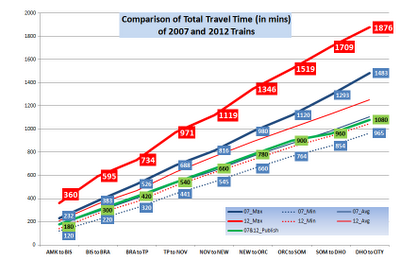Aim
This empirical study is a follow-up from the previous one conducted in 2007 after my trip to Japan.
https://sites.google.com/site/alwinwoo/mrtlogs
Inspired by the recent challenges that the transportation system exhibited (in particularly the trains), instead of relying on gut feel, I wanted to find out the following:
- If the trains actually (empirically) ran slower
- If they did, by how much (empirically)
- Whether if the drop in performance was station-specific
Methodology
Having changed jobs and with a duty to ferry my school-going kids, this new study recorded the timings of trains leaving Ang Mo Kio in the morning between 8.30 to 8.45am in the direction of Outram Park. The return journey was taken on trains between 6.15 to 6.30pm.
Using a stopwatch application for my Nokia E7, timings were taken when the train doors opened at each station. All timings were to the nearest second.
Results
Table 1: Log of Travel Times in 2007 from Ang Mo Kio to City Hall
Table 2: Log of Travel Times in 2012 from Ang Mo Kio to Outram Park
Following the same methodology in 2007 (Table 1), 2 weeks' worth of data was collected between 13 and 24 August on travel times between Ang Mo Kio and Outram Park (Table 2).
The first instance of a date indicates the times taken to travel between two stations on the southbound trip (towards office); the second represents the times taken on the northbound trip (home).
Detection of Outliers
Not done during the 2007 study is a check to determine if there were any outliers (in this study, outliers are defined as timing values that are 140% or more than the nearest value). This was applied to both the maximum and minimum timings recorded in both periods.
2 maxima outliers highlighted in yellow (one each in 2007 and 2012) were detected and thus omitted from the results. The maximum times were then adjusted to 141 and 148 (from 224 and 212) respectively.
There were no minima outliers.
Determining Maximum, Minimum and Standard Deviation of Travel Times
With adjustments to the 2 maxima outliers, the following four graphs (1 to 4) were plotted to determine and compare the maximum, minimum and standard deviation of the travel times taken in 2007 and 2012.
Graph 1: Minimum, Maximum and Standard Deviation of Travel Times in 2007
Graph 2: Minimum, Maximum and Standard Deviation of Travel Times in 2012
Graph 3: Cumulative Travel Times (Min, Average, Max) in 2007, 2012
with publicly available SMRT timings
with publicly available SMRT timings
Graph 4: Range of Travel Times between AMK and City Hall Stations
based on 2007 baseline (minimum) and 2012 ceiling (maximum)
based on 2007 baseline (minimum) and 2012 ceiling (maximum)
Conclusion
Based on the following graphs, some of the more significant (in my opinion) observations are highlighted below:
- This study empirically shows that travel times have increased; this is accompanied by greater variance in travel times, particularly at the AMK and Bishan stations
- Travel times from AMK to Bishan can potentially increase by 200% when compared to 2007's fastest time (from 120 to 360 seconds)
- The variance of travel times between Braddell~Toa Payoh and Dhoby Ghaut~City Hall actually decreased from 2007 to 2012
- The published travel times from SMRT reflected the average travel time in 2007 and are slightly higher than the fastest (most optimistic) travel time in 2012
- The cumulative travel time lines (fastest and average times for 2007 and 2012) from AMK to City Hall are almost parallel
- The time difference between the fastest travel times in 2007 and 2012 was less than 2 mins
- The difference between the estimated travel time and slowest travel times in 2012 are quite significant (180 vs 360, 780 vs 1346, 1080 vs 1876)
- The time difference between estimated and average travel time in 2012 is about 2 mins
Wrap-Up
This begets another interesting question that I intend to follow up to find out more, which is:
"If travel time has only changed by 2 minutes, why then does the train trip take so much longer?"






